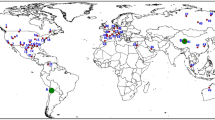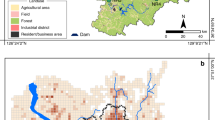Abstract
Lithium is found at low concentrations in the major rivers of the United States (about 0.002 mg l−1) and as a mineral or salt in pegmatites and brines. The United States produces many lithium materials and consumes the greatest amount of Li in the world for use in ceramics, glass, aluminum, pharmaceuticals, batteries, etc. From 1950 to 1970, Li was central to many nuclear-related US Department of Energy (DOE) activities. The historical and current use of Li has not prompted many studies of the toxicity of this element to aquatic organisms. Here, we review the distribution and use of Li in the US with emphasis on usage by DOE. We also summarize information on the toxicity of lithium to aquatic biota. A case-example is provided which demonstrates the potential for contamination of groundwater with Li, evaluates the toxicity of the Li-contaminated groundwater, and identifies a treatment alternative.
Similar content being viewed by others
References
Allen, H.E. and Halley-Henderson, M.A. Hass, C.N. (1989). Chemical composition of bottled mineral water. Arch. Environ. Health 44, 102-16.
Anderson, B.G. (1946). The toxicity threshold of various sodium salts determined by the use of Daphnia magna. Sewage Works J. 18, 82-7.
Anderson, M.A., Bertsch, P.M. and Miller, W.P. (1988). The distribution of lithium in selected soils and surface waters of the southeastern USA. Appl. Geochem. 3, 205-12.
Backstrom, S. (1953). Morphogenetic effects of lithium on the embryonic development of Xenopus. Arkiv. Zool. 6, 527-36.
Bencala, K.E., McKnight, D.M. and Zellweger, G.W. (1990). Characterization of transport in an acidic and metal-rich mountain stream based on a lithium tracer injection and simulations of transient storage. Water Resources Res. 26, 989-1000.
Biwa, W.B. and Gimlich, R.L. (1989). Lithium-induced teratogenesis in frog embryos prevented by a polyphosphoinositide cycle intermediate or a diacylglyceral analog. Develop. Biol. 132, 315-24.
Bleiwas, D.I. and Coffman, J.S. (1986). Lithium availability-market economy countries, Bureau of Mines Information Circular 9102, 23 pp.
Bradford, G.R. (1963). Lithium survey of California's water resources. Soil Sci. 96, 77-81.
Bustuoabad, O.D., Herkovits, J. and Pisano, A. (1977). Different sensitivity to lithium ion during the segmentation of Bufo arenarum eggs. Acta Embryol. Exper. 3, 271-82.
Cannon, H.L., Harms, T.F. and Hamilton, J.C. (1975). Lithium in unconsolidated sediments and plants of the basin and range province, Southern California and Nevada, Geological Survey Professional Paper 918, US Government Printing Office: Washington, DC.
Cole, G.A. (1994). Textbook of Limnology, Prospect Heights IL: Waveland Press.
Comer, E.P. (1978). The lithium industry today. Energy 3, 237-40.
DOE (Department of Energy). (1993). Environmental assessment for the sale of excess lithium hydroxide stored at the Oak Ridge K-25 site and the Portsmouth Gaseous Diffusion Plant, DOE/EA-0855, 36 pp.
DOE (US Department of Energy) (1995). Materials in inventory, management strategy for lithium (revised), ES/M-9/V5/R1, US Department of Energy, Oak Ridge Operations Office, Office of Defense Program: Oak Ridge, Tennessee, 47 pp.
DOE (US Department of Energy) (2001). DOE completes sale and removal of lithium compounds at portsmouth plant. Media Release, Accessed November 12, 2001, URL: http://www.oakridge.doe.gov/media_releases/2001/r-01-042Ports.htm.
Durfor, C.N. and Becker, E. (1964). Public water supplies of the 100 largest cities in the United States, 1962, US Geological Survey Water Supply Paper 1812, 364 p.
Dwyer, F.J., Burch, S.A., Ingersoll, C.G. and Hunn, J.B. (1992). Toxicity of trace element and salinity mixtures to striped bass (Morone saxatilis) and Daphnia magna. Environ. Toxicol. Chem. 11, 513-520.
Emery, R.D., Klopfer, C. and Skalski, J.R. (1981). The incipient toxicity of lithium to freshwater organisms representing a salmonid habitat. PNL-3640, UC-11 Pacific Northwest Laboratory: Richland, WA, 364 p.
EPA (US, Environmental, Protection, Agency). (1994). Short-term methods for estimating the chronic toxicity of effluents and receiving water to freshwater organisms, EPA/600/4-91/002, US Environmental Protection Agency, Environmental Monitoring Systems Laboratory: Cincinnati, OH.
ESERP (Energy, Systems, Environmental, Restoration, Program). (1997). Report on the Remedial Investigation of Bear Creek Valley at the Oak Ridge Y-12 Plant, Oak Ridge, Tennessee. Vol. 6, Appendix G—Baseline Ecological Risk Assessment Report. DOE/OR/01-2455/V6&D2, Oak Ridge National Laboratory: Oak Ridge, TN.
Evans, R.K. (1978). Lithium reserves and resources. Energy 3, 379-85.
Feder, G.L. (1972). Geochemical survey of Missouri, open file report, United States Geological Survey.
FMC Corporation. (1992). Lithium, FMC Corporation publication, 13 pp.
Fouillac, C. and Michard, G. (1981). Sodium/lithium ratio in water applied to geothermometry of geothermal reservoirs. Geothermics 10, 55-70.
Gouin, T., Thomas, G.O., Cousins, I., Barber, J., Jackay, D. and Jones, K.C. (2001). Air-surface exchange of polybrominated biphenyl ethers and polychlorinated biphenyls. Environ. Sci. Technol. 36, 1426-34.
Hall, T.S. (1942). The mode of action of lithium salts in amphibian development. J. Exp. Zool. 89, 1-30.
Hallock, R.J. and Hallock, L.L. (eds.) (1993). Detailed study of irrigation drainage in and near wildlife management areas, west-central Nevada, 1987–1990. Part B. Effect on biota in Strillwater and Fernley Wildlife Management Areas and Other Nearby Wetlands, US Geological Survey, Water-Resources Investigations Report 92-4024B, US Geological Survey, US Fish and Wildlife Service, US Bureau of Reclamation, and US Bureau of Indian Affairs: Carson City, NV.
Hamilton, S.J. (1995). Hazard assessment of inorganics to three endangered fish in the Green River, Utah. Ecotoxicol. Environ. Safety 30, 134-42.
Hem, J.D. (1992). Study and Interpretation of the Chemical Characteristics of Natural Water, 3rd edn. US Geological Survey Water-Supply Paper 2254, Washington, DC: U.S Government Printing Office.
Hill, B.R. and Gilliom, R.J. (1993). Streamflow, dissolved solids, suspended sediment, and trace elements, San Joaquin River, California, June 1985–September 1988, United States Geologial Survey Open-File Report, Water-Resources Investigations Report 93-4085, Denver: Colorado.
Hutchinson, G.E. (1975). A Treatise on Limnology. Part 2—Chemistry of Lakes. New York: John Wiley.
Kszos, L.A. and Stewart, A.J. (2003). Toxicity of lithium to three aquatic organisms and the antagonistic effect of sodium. Ecotoxicology 12, 427-437.
Kszos, L.A., Stewart, A.J., Wicker, L.F., Roberson, L.E., Phipps, T.L. and Gonzalez, A.M. (1996). Environmental Sciences Division, Toxicology Laboratory Quality Assurance Program, QAP-X-89-ES-002, Rev. 1 Oak Ridge National Laboratory: Oak Ridge, TN.
Lazou, A. and Beis, A. (1993). Lithium induces changes in the plasma membrane protein pattern of early amphibian embryos. Biol. Cell. 73, 265-8.
Long, K.E., Brown, R.P. Jr and Woodburn, K.B. (1998). Lithium chloride: a flow-through embryo-larval toxicity test with the fathead minnow, Pimephales promelas Rafinesque. Bull. Environ. Contam. Toxicol. 60, 312-17.
Manchester-Neesvig, J.B., Valters, K. and Sonzogni, W.C. (2001). Comparison of polybrominated diphenyl ethers (PBDEs) and polychlorinated biphenyls (PCBs) in Lake Michigan salmonids. Environ. Sci. Technol. 35, 1072-7.
Mathis, B.J. and Cummings, T.F. (1973). Selected metals in sediments, water and biota of the Illinois River. J. Water Pollution Control Federation 45, 1573-83.
National Research, Council. (1989). The Nuclear Weapons Complex: Management for Health, Safety, and the Environment. Appendix B: A Descriptive Overview, Washington, DC: National Academy Press.
Ober, J.A. (2001). Lithium-2000 In Minerals Yearbook, vol. I, Metals & Minerals, pp. 47.1-47.6. US Geological Survey, Minerals Information: Reston, VA, http://minerals.usgs.gov/minerals/pubs/commodity/lithium/.
S.S. Penner (1978). Symposium on lithium needs and resources. Energy 3, 235-418.
Probst, D.A. and Pratt, W.P. (1978). United States Mineral Resources, Geological Survey Professional Paper 820, US Government Printing Office: Washington, DC.
Shacklette, H.T. and Boerngen, J.G. (1984). Element concentrations in soils and other surficial materials of the conterminous United States, U.S. Geological Survey Professional Paper 1270, US Government Printing Office: Washington, DC, 105 p.
Shacklette, H.T., Boerngen, J.G., Cahill, J.P. and Rahill, R.L. (1973). Lithium in surficial materials of the conterminous United States and partial data on cadmium, US Geological Survey Circular 673, 8 p.
Sievers, M.L. and Cannon, H.L. (1975). Disease patterns of Pima Indians of the Gila River Indian Reservation of Arizona in relation to the geochemical environment. In D.D. Hemphill (ed.), Trace Substances in Environmental Health—VII, pp. 57-61. Missouri: University of Missouri Press.
Stewart, A.J. and Kszos, L.A. (1996). Caution on using lithium (Li+) as a conservative tracer in hydrological studies. Limnol. Oceanogr. 41, 190-1.
Stockard, C.R. (1906). The development of Fundulus heteroclitus in solutions of lithium chloride, with appendix on its development in fresh water. J. Exp. Zool. 3, 99-120.
Subba Rao, D.V, Pan, Y. and Mukhida, K. (1998). Production of domoic acid by Pseudo-nitzschia multiseries Hasle, affected by lithium. Marine Ecol. 19, 31-6.
Tanner, D.Q. (1995). Surface-water-quality assessment of the lower kansas river basin, Kansas and Nebraska: Distribution of trace-element concentrations in dissolved and suspended phases, streambed sediment, and fish samples, May 1987–April 1990. Lawrence, Kansas: USGS Water-Resources Investigations Report 94-4201, Denver, Colorado.
Tate, C.M., Broshears, R.E. and McKnight, D.M. (1995). Phosphate dynamics in an acidic mountain stream: Interactions involving algal uptake, sorption by iron oxide, and protoreduction. Limnol. Oceanogr. 40, 938-46.
Vine, J.D. (ed.) (1976). Lithium resources and requirements by the year 2000, United States Geological Survey Professional Paper 1005, Washington, DC.
Vine, J.D. and Dooley, J.R. Jr. (1980). Where on earth is all the lithium? With a section on uranium isotope studies, Fish Lake Valley, Nevada, United States Geological Survey open-file report 80-1234, Denver: Colorado.
Wetzel, R.G. (1983). Limnology, 2nd edn. Philadelphia, PA: Saunders College Publishing.
Author information
Authors and Affiliations
Corresponding author
Rights and permissions
About this article
Cite this article
Kszos, L.A., Stewart, A.J. Review of Lithium in the Aquatic Environment: Distribution in the United States, Toxicity and Case Example of Groundwater Contamination. Ecotoxicology 12, 439–447 (2003). https://doi.org/10.1023/A:1026112507664
Issue Date:
DOI: https://doi.org/10.1023/A:1026112507664




